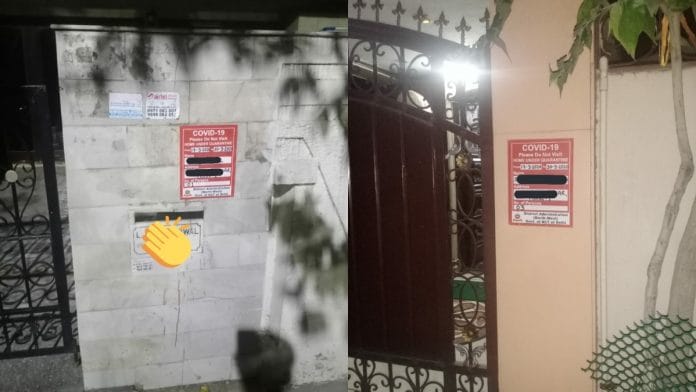New Delhi: The Delhi government has started the process of marking homes of people advised to stay in quarantine in the wake of the coronavirus outbreak. The move, it says, is aimed at “cautioning others for their own safety”.
Chief Minister Arvind Kejriwal Sunday tweeted clarifying the purpose of the exercise.
“Delhi govt is marking all homes with persons advised to home quarantine. I appeal to all not to stigmatize such families. Please be empathetic and supportive towards them,” he wrote in the post.
Delhi govt is marking all homes with persons advised to home quarantine. I appeal to all not to stigmatize such families. Please be empathetic and supportive towards them. The marking is aimed only at cautioning others for their own safety. #DelhiFightsCorona https://t.co/4U0CbwaOQG
— Arvind Kejriwal (@ArvindKejriwal) March 22, 2020
In Chandigarh too, the Union Territory Administration has started labelling houses of those who have been recommended home quarantine to alert visitors.
#Chandigarh #admin is putting these notices outside homes where #quarantine is required. Simple & sensible. #coronavirusinindia pic.twitter.com/ikc5LQrk8M
— Dr Sumita Misra IAS (@sumitamisra) March 21, 2020
This is, however, not unprecedented. Similar measures have been taken in the past to isolate people during epidemics and pandemics.
“…societies have, since ancient times, used strategies to isolate persons with disease from unaffected persons,” infectious disease specialist Paul S. Sehdev wrote in his paper on The Origin of Quarantine.
Also read: Why Singapore isn’t in a coronavirus lockdown — as told by a doctor of the country
Here is a list of a few such instances from the past.
Yellow fever
The ‘yellow flag’ has remained a universal symbol of quarantine, especially in maritime history. These flags, which are sometimes referred to as the ‘yellow jack’, were hoisted on ships when there was an outbreak of yellow fever or cholera. In Gabriel Garcia Marquez’s fiction book Love in The Time of Cholera, which is set in what seems to be 19th century Colombia, protagonist Florentino Ariza hoists the yellow flag of cholera.
Great plague of 1665
Among the most well-known instances of houses being marked is the bubonic plague in London, which lasted from 1665 to 1666. Houses of plague victims were sealed off and a red cross was marked on the doors along with the words, ‘Lord, have mercy on us’.
English writer Daniel Defoe, in his novel ‘A Journal of the Plague Year’, documented the orders that were given by the mayor at the time. “That every house visited be marked with a red cross of a foot long in the middle of the door, evident to be seen, and with these usual printed words, that is to say, ‘Lord, have mercy upon us’ to be set close over the same cross, there to continue until lawful opening of the same house,” Defoe had written.
1918 Spanish flu
The devastating Spanish flu of 1918 claimed an estimated 50 to 100 million lives worldwide. The period saw people collapsing and dying everywhere from the pandemic.
In India, the Spanish influenza claimed somewhere between 10 and 20 million lives. Social distancing became a widespread practice. In some countries, shaking hands was made illegal. In the United States, families put crepe paper on doorways to mark deaths inside — white for babies, purple for younger people.
Samoa measles outbreak in 2019
Last year, during the measles outbreak in Samoa — an island nation in the Pacific Ocean — the government used the centuries-old tactic asking people to hang red flags outside houses where people had not been vaccinated. The government at the time, led by Prime Minister Tuilaepa Sailele Malielegaoin, had hoped that this strategy would expedite the door-to-door vaccination campaigns that had been launched to combat the outbreak.
Also read: India locks down to prevent COVID-19 spread — here are restrictions imposed in your state






